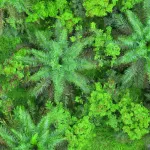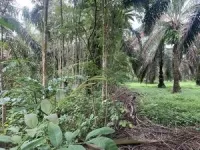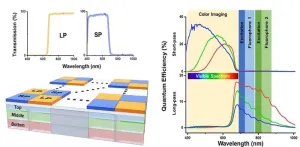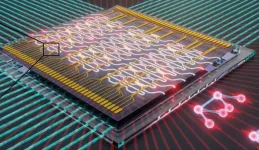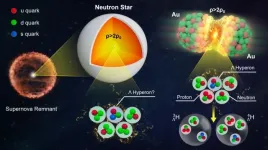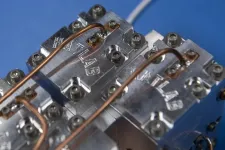(Press-News.org) Islands of trees in oil palm plantations can significantly increase biodiversity within five years without reducing productivity. This has been shown by an experiment, which has been running for over ten years in Indonesia as part of the Collaborative Research Centre (CRC) "EFForTS" at the University of Göttingen. An international team of researchers led by Göttingen planted experimental islands of trees in plantations on the island of Sumatra to counteract the species loss caused by the intensive cultivation of oil palms. The results have been published in the journal Nature.
The conversion of tropical forests into oil palm plantations leads to considerable losses of biodiversity and ecological functions. Worldwide, a total of about 21 million hectares of palm oil plantations are cultivated, mainly in Indonesia and Malaysia. To mitigate the negative impact on the environment, the scientists established 52 tree islands with local tree species in an industrial oil palm plantation. This has turned out to be a promising strategy for ecological restoration.
The research team had expected yields to deteriorate over time as the tree islands consumed resources for their own development at the expense of the oil palms. "However, even after five years after the experiment began, the oil palms have continued to flourish. And this has been accomplished without the use of artificial fertiliser in the tree islands," explains first author Professor Delphine Clara Zemp, now at the University of Neuchâtel. "Our results show that the industry can benefit from this intervention. There is real potential to develop these methods to enrich biodiversity on a large scale."
"Most studies of the ecology of palm oil plantations are limited to observing the loss of biodiversity and deterioration of the ecosystem," explains co-author Professor Holger Kreft, Head of Göttingen University’s Biodiversity, Macroecology and Biogeography Research Group. "Our approach to ecological restoration goes a step further and is unique worldwide, as it takes place against the backdrop of industrial-scale oil palm plantations across large areas. Using a rigorous experimental design, we can determine the optimal composition and size of islands of trees that will bring about the best possible way to restore the ecology."
The researchers analysed the biodiversity of soil microorganisms (such as bacteria or fungi), insects and other small invertebrates, plants, birds and bats three to five years after establishing the experiment. They also quantified the impacts in terms of water, carbon and nutrient cycle regulation, microclimate, soil quality, pollination and control of biological communities and invasive species. Close cooperation with the owners of the plantation was essential for the smooth running of the research project. "The collaboration helped us to better understand issues relating to the agricultural and economic management of the plantation and how our experimental trials affect oil palm yields. These aspects are crucial for the industry," says Zemp.
However, the 40 authors of the study agreed that the top priority must continue to be the prevention of deforestation: "The encouraging results must not be allowed to jeopardise the conservation of tropical forests, which are home to irreplaceable biodiversity," the team concludes.
The Collaborative Research Centre "Ecological and Socio-economic Functions of Tropical Lowland Rainforest Transformation Systems (EFForTS)" is funded by the German Research Foundation (DFG). Further information can be found here: www.uni-goettingen.de/efforts. Contributions to this paper are from researchers around the world including those at the Institut Pertanian Bogor and Jambi University in Indonesia, the universities of Neuchâtel in Switzerland, Hohenheim in Germany, and the German Centre for Integrative Biodiversity Research (iDiv) Halle-Jena-Leipzig.
Original publication: Delphine Clara Zemp et al. Tree islands enhance biodiversity and functioning in oil palm landscapes. Nature 2023. https://doi.org/10.1038/s41586-023-06086-5.
Contact:
Professor Holger Kreft
University of Göttingen
Biodiversity, Macroecology and Biogeography Research Group
Tel: +49 (0)551 39-28757
Email: hkreft@uni-goettingen.de
www.uni-goettingen.de/de/128741.html
END
Tree islands bring biodiversity to oil palm plantations
International research team led by Göttingen University shows method increases biodiversity without affecting yield
2023-05-26
ELSE PRESS RELEASES FROM THIS DATE:
Innovative endoscopic imaging system can detect multiple fluorescent tracers
2023-05-26
For patients with solid cancers, endoscopic surgery is one of the primary treatment options to remove tumors. However, there is a high risk of cancer recurrence if even a small number of cancerous cells are left behind after surgical resection. To prevent this from happening, researchers developed fluorescence-guided surgery (FGS). In FGS, patients are injected with a fluorescent probe that preferentially binds to tumor cells, enabling surgeons to easily identify lesions with the help of specialized endoscopes that emit the necessary excitation light.
Unfortunately, tumors can be highly heterogeneous, ...
CHOP researchers show that IgA fine tunes the body’s interactions with microbes
2023-05-26
Philadelphia, May 26, 2023—IgA deficiency is the most common primary immune deficiency worldwide, but its presentation has puzzled physcians and researchers. Some with the disorder present with symptoms like recurrent infections, autoimmune disease, or allergies, whereas others have no symptoms at all and only become aware of their IgA-deficient status through an incidental finding on a blood test. This variability has raised the question among researchers: Why aren’t many of those with IgA deficiency sicker?
A new study by researchers at Children’s ...
Protein-based nano-‘computer’ evolves in ability to influence cell behavior
2023-05-26
HERSHEY, Pa. — The first protein-based nano-computing agent that functions as a circuit has been created by Penn State researchers. The milestone puts them one step closer to developing next-generation cell-based therapies to treat diseases like diabetes and cancer.
Traditional synthetic biology approaches for cell-based therapies, such as ones that destroy cancer cells or encourage tissue regeneration after injury, rely on the expression or suppression of proteins that produce a desired action within a cell. This approach can take time (for proteins ...
Gene therapy rescues hearing for the first time in aged mouse models
2023-05-26
By 2050, one in 10 individuals are expected to live with some form of hearing loss. Of the hundreds of millions of cases of hearing loss affecting individuals worldwide, genetic hearing loss is often the most difficult to treat. While hearing aids and cochlear implants offer limited relief, no available treatment can reverse or prevent this group of genetic conditions, prompting scientists to evaluate gene therapies for alternative solutions.
One of the most promising tools used in these therapies—adeno associated virus (AAV) vectors—has galvanized the hearing-loss community in recent years. ...
The mechanisms behind swallowing
2023-05-26
Sensory cells in the vagus nerve can detect and locate food in the esophagus. Their signals help transport the food onward to the stomach. Signal failure leads to swallowing disorders, say a team led by Carmen Birchmeier at the Max Delbrück Center. They have published their findings in “Neuron.”
Swallowing disorders can have many causes, and they occur more frequently in older people. But neurological diseases such as multiple sclerosis and Parkinson’s disease, and certain medications, can also prevent food moving normally from mouth to stomach. Possible consequences include malnutrition, weight loss, and dehydration.
Now a team led ...
Life through rose-coloured glasses
2023-05-26
Over thousands of years some animals have specialised to live in environments where the sun never shines: giant squid with eyes the size of volleyballs see even in the darkest depths while others, like cave-dwelling olms, have lost the functionality of their eyes completely. But for animals that do not live in these extremes, how do species manage a world that suddenly becomes dark? Lakes that become turbid from algal blooms, agricultural run-off, or other environmental pollutants represent common examples of environmental disturbances that can impact the visual scene that ...
Promising building blocks for photonic quantum simulators
2023-05-26
Researchers at the Niels Bohr Institute have, collaborating with the University of Münster and Ruhr-Universität Bochum, developed new technology capable of processing the enormous amounts of information quantum systems generate. Deterministic single photon light sources, creating quantum bits at extreme rates and speed are now coupled to specially designed, integrated photonic circuits, capable of processing quantum information with adequate speed and quality without degrading the susceptible quantum states. This means that the first steps have been taken towards the development of photonic quantum devices that can, for example, ...
First measurements of hypernuclei flow at RHIC
2023-05-26
UPTON, NY—Physicists studying particle collisions at the Relativistic Heavy Ion Collider (RHIC) have published the first observation of directed flow of hypernuclei. These short-lived, rare nuclei contain at least one “hyperon” in addition to ordinary protons and neutrons. Hyperons contain at least one “strange” quark in place of one of the up or down quarks that make up ordinary nucleons (the collective name for protons and neutrons). Such strange matter is thought to be abundant in the hearts of neutron stars, which are among the densest, most exotic objects in the universe. While blasting off to neutron stars to study ...
When the cell digests itself: How inherited neurodegenerative diseases develop
2023-05-26
FRANKFURT. A tangle of pockets, tubes and sac-like membrane structures runs through the cells of humans, animals, plants and fungi: the endoplasmic reticulum, or ER for short. In the ER, proteins are manufactured, folded into their three-dimensional structure and modified, lipids and hormones are produced and calcium concentrations in the cell are controlled. In addition, the ER forms the basis for the cellular transport system, feeds misfolded proteins to intracellular disposal and renders toxins that have entered the cell harmless.
In ...
Army funds two quantum-related projects at Pitt
2023-05-26
The U.S. Army has awarded more than $5.7 million for two projects led by Michael Hatridge, associate professor of physics and astronomy in the Kenneth P. Dietrich School of Arts and Sciences. Both projects bring together a diverse group of researchers to overcome roadblocks in the field of quantum computing.
A four-year, $2.67 million grant is aimed at the next generation of modular quantum computing systems. Hatridge and co-principal investigators Robert Schoelkopf of Yale University have each developed unique ...
LAST 30 PRESS RELEASES:
From novel therapies to first-in-human trials, City of Hope advances blood cancer care at the American Society of Hematology (ASH) annual conference
Research aims to strengthen the security of in-person voting machines
New study exposes hidden Alzheimer’s 'hot spots' in rural Maryland and what they reveal about America’s growing healthcare divide
ASH 2025: Study connects Agent Orange exposure to earlier and more severe cases of myelodysplastic syndrome
ASH 2025: New data highlights promise of pivekimab sunirine in two aggressive blood cancers
IADR elects George Belibasakis as vice-president
Expanding the search for quantum-ready 2D materials
White paper on leadership opportunities for AI to increase employee value released by University of Phoenix College of Doctoral Studies
ASH 2025: New combination approach aims to make CAR T more durable in lymphoma
‘Ready-made’ T-cell gene therapy tackles ‘incurable’ T-cell leukemia
How brain activity changes throughout the day
Australian scientists reveal new genetic risk for severe macular degeneration
GLP-1 receptor agonists likely have little or no effect on obesity-related cancer risk
Precision immunotherapy to improve sepsis outcomes
Insilico Medicine unveils winter edition of Pharma.AI, accelerating the path to pharmaceutical superintelligence
Study finds most people trust doctors more than AI but see its potential for cancer diagnosis
School reopening during COVID-19 pandemic associated with improvement in children’s mental health
Research alert: Old molecules show promise for fighting resistant strains of COVID-19 virus
Journal of Nuclear Medicine Technology supplement highlights advances in theranostics and opportunities for growth
New paper rocks earthquake science with a clever computational trick
ASH 2025: Milder chemo works for rare, aggressive lymphoma
Olfaction written in bones: New insights into the evolution of the sense of smell in mammals
Engineering simulations rewrite the timeline of the evolution of hearing in mammals
New research links health impacts related to 'forever chemicals' to billions in economic losses
Unified EEG imaging improves mapping for epilepsy surgery
$80 million in donations propels UCI MIND toward world-class center focused on dementia
Illinois research uncovers harvest and nutrient strategies to boost bioenergy profits
How did Bronze Age plague spread? A sheep might solve the mystery
Mental health professionals urged to do their own evaluations of AI-based tools
Insufficient sleep associated with decreased life expectancy
[Press-News.org] Tree islands bring biodiversity to oil palm plantationsInternational research team led by Göttingen University shows method increases biodiversity without affecting yield
